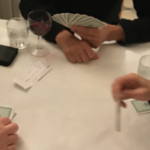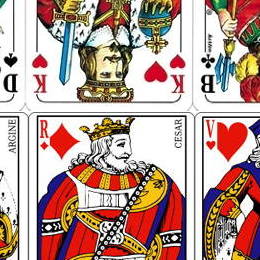Playing Games in Europe : Doppelkopf

As lovers of Doppelkopf we’ve long wondered how we could organise a Doppelkopf group here in France. Would the French be likely to take up this typically German game? And how do we explain in French the different versions of the game?
One evening when we were chatting with our Parisian friends, the conversation turned to belote and we noticed that the French card game had certain similarities to our Doppelkopf (for example it is played 2 against 2). That piqued the curiosity of our friends, passionate card players, and we took the adventurous step of teaching them to play Doppelkopf - not an easy thing even with Germans who have never played it. First of all they had to learn what the following meant: “Stechen” (cut), “Trumpf” (trump), and “Stich” (trick).
To start with we tried to translate everything as simply as we could, so “Dame”(queen), “König” (king), or “Bube” (knave). That went well. But on the first evening we only had available a mixture of French and German cards, so “Buben”(German) and “valets” (French), which was rebaptised in the blink of an eye by our friends as “balets”. For them it was abnormal that every card was double. The peculiarities of “Herz zehn” (ten of hearts), “Fuchs”(fox) and “Karlchen Müller“ were also difficult to explain. But little by little our friends learnt the sequence of trumps and the difference in colour between clubs, spades and hearts, and that diamonds are always trumps.
On that first evening we played several games using the basic rules, and the play became more and more relaxed. But it was clear that we would need a couple more learning sessions to get into the detail. By the third evening, the basics had been established, but our friends had to leave. We are sure that we will be playing Doppelkopf with them again when they are next in the Médoc!
2022 Christian/Elke Schwichtenberg (Grayan-et-l'Hôpital), translation: Margaret and Richard Beasley

